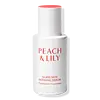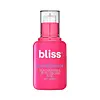What's inside
What's inside
 Key Ingredients
Key Ingredients

 Benefits
Benefits

 Concerns
Concerns

 Ingredients Side-by-side
Ingredients Side-by-side

Water
Skin ConditioningPropanediol
SolventButylene Glycol
HumectantNiacinamide
Smoothing1,2-Hexanediol
Skin ConditioningPrunus Persica Fruit Extract
AbrasiveDioscorea Japonica Root Extract
Skin ConditioningSodium Hyaluronate
HumectantAdenosine
Skin ConditioningHydrolyzed Sodium Hyaluronate
Skin ConditioningMadecassoside
AntioxidantHydrolyzed Hyaluronic Acid
HumectantSodium Acetylated Hyaluronate
HumectantAcetyl Octapeptide-3
HumectantEthylhexylglycerin
Skin ConditioningHydrolyzed Corn Starch
HumectantSodium Carbomer
Emulsion StabilisingBeta-Glucan
Skin ConditioningSaccharide Isomerate
HumectantPhytic Acid
Sucrose
HumectantAsiaticoside
AntioxidantCaprylyl Glycol
EmollientWater, Propanediol, Butylene Glycol, Niacinamide, 1,2-Hexanediol, Prunus Persica Fruit Extract, Dioscorea Japonica Root Extract, Sodium Hyaluronate, Adenosine, Hydrolyzed Sodium Hyaluronate, Madecassoside, Hydrolyzed Hyaluronic Acid, Sodium Acetylated Hyaluronate, Acetyl Octapeptide-3, Ethylhexylglycerin, Hydrolyzed Corn Starch, Sodium Carbomer, Beta-Glucan, Saccharide Isomerate, Phytic Acid, Sucrose, Asiaticoside, Caprylyl Glycol
Water
Skin ConditioningNiacinamide
SmoothingGlycerin
HumectantPropanediol
SolventAloe Barbadensis Leaf Juice
Skin ConditioningCoco-Caprylate/Caprate
EmollientDimethicone
EmollientC15-19 Alkane
SolventSodium Hyaluronate
HumectantTocopherol
AntioxidantTocopheryl Acetate
AntioxidantGlycyrrhiza Glabra Root Extract
BleachingGlycine Soja Oil
EmollientHelianthus Annuus Seed Oil
EmollientAvena Sativa Kernel Oil
Skin ConditioningXanthan Gum
EmulsifyingAcacia Senegal Gum
MaskingCetearyl Olivate
Saccharide Isomerate
HumectantCaprylyl Glycol
EmollientShea Butter Ethyl Esters
EmollientPolyacrylate Crosspolymer-6
Emulsion StabilisingHydroxyethyl Acrylate/Sodium Acryloyldimethyl Taurate Copolymer
Emulsion StabilisingPolyglyceryl-4 Laurate/Succinate
Sorbitan Olivate
EmulsifyingGlyceryl Stearate
EmollientLauryl Glucoside
CleansingHexylene Glycol
EmulsifyingSodium Citrate
BufferingPhenoxyethanol
PreservativeEthylhexylglycerin
Skin ConditioningPotassium Sorbate
PreservativeSodium Benzoate
MaskingCitric Acid
BufferingSodium Hydroxide
BufferingParfum
MaskingWater, Niacinamide, Glycerin, Propanediol, Aloe Barbadensis Leaf Juice, Coco-Caprylate/Caprate, Dimethicone, C15-19 Alkane, Sodium Hyaluronate, Tocopherol, Tocopheryl Acetate, Glycyrrhiza Glabra Root Extract, Glycine Soja Oil, Helianthus Annuus Seed Oil, Avena Sativa Kernel Oil, Xanthan Gum, Acacia Senegal Gum, Cetearyl Olivate, Saccharide Isomerate, Caprylyl Glycol, Shea Butter Ethyl Esters, Polyacrylate Crosspolymer-6, Hydroxyethyl Acrylate/Sodium Acryloyldimethyl Taurate Copolymer, Polyglyceryl-4 Laurate/Succinate, Sorbitan Olivate, Glyceryl Stearate, Lauryl Glucoside, Hexylene Glycol, Sodium Citrate, Phenoxyethanol, Ethylhexylglycerin, Potassium Sorbate, Sodium Benzoate, Citric Acid, Sodium Hydroxide, Parfum
 Reviews
Reviews

Ingredients Explained
These ingredients are found in both products.
Ingredients higher up in an ingredient list are typically present in a larger amount.
Caprylyl Glycol is a humectant and emollient, meaning it attracts and preserves moisture.
It is a common ingredient in many products, especially those designed to hydrate skin. The primary benefits are retaining moisture, skin softening, and promoting a healthy skin barrier.
Though Caprylyl Glycol is an alcohol derived from fatty acids, it is not the kind that can dry out skin.
This ingredient is also used as a preservative to extend the life of products. It has slight antimicrobial properties.
Learn more about Caprylyl GlycolEthylhexylglycerin (we can't pronounce this either) is commonly used as a preservative and skin softener. It is derived from glyceryl.
You might see Ethylhexylglycerin often paired with other preservatives such as phenoxyethanol. Ethylhexylglycerin has been found to increase the effectiveness of these other preservatives.
Niacinamide is a multitasking form of vitamin B3 that strengthens the skin barrier, reduces pores and dark spots, regulates oil, and improves signs of aging.
And the best part? It's gentle and well-tolerated by most skin types, including sensitive and reactive skin.
You might have heard of "niacin flush", or the reddening of skin that causes itchiness. Niacinamide has not been found to cause this.
In very rare cases, some individuals may not be able to tolerate niacinamide at all or experience an allergic reaction to it.
If you are experiencing flaking, irritation, and dryness with this ingredient, be sure to double check all your products as this ingredient can be found in all categories of skincare.
When incorporating niacinamide into your routine, look out for concentration amounts. Typically, 5% niacinamide provides benefits such as fading dark spots. However, if you have sensitive skin, it is better to begin with a smaller concentration.
When you apply niacinamide to your skin, your body converts it into nicotinamide adenine dinucleotide (NAD). NAD is an essential coenzyme that is already found in your cells as "fuel" and powers countless biological processes.
In your skin, NAD helps repair cell damage, produce new healthy cells, support collagen production, strengthen the skin barrier, and fight environmental stressors (like UV and pollution).
Our natural NAD levels start to decline with age, leading to slower skin repair, visible aging, and a weaker skin barrier. By providing your skin niacinamide, you're recharging your skin's NAD levels. This leads to stronger, healthier, and younger looking skin.
Another name for vitamin B3 is nicotinamide. This vitamin is water-soluble and our bodies don't store it. We obtain Vitamin B3 from either food or skincare. Meat, fish, wheat, yeast, and leafy greens contain vitamin B3.
The type of niacinamide used in skincare is synthetically created.
Learn more about NiacinamidePropanediol is an all-star ingredient. It softens, hydrates, and smooths the skin.
It’s often used to:
Propanediol is not likely to cause sensitivity and considered safe to use. It is derived from corn or petroleum with a clear color and no scent.
Learn more about PropanediolSaccharide Isomerate comes from sugars found in corn. It is a skin hydrator.
The structure of this ingredient can be altered to be more similar to the carbohydrates found in our skin. This ability to mimic our skin gives it hydrating properties.
Specifically, saccharide Isomerate is a humectant. Humectants draw moisture from the air to our skin.
Research shows Saccharide Isomerate to be an effective moisturizer.
Learn more about Saccharide IsomerateSodium Hyaluronate is hyaluronic acid's salt form. It is commonly derived from the sodium salt of hyaluronic acid.
Like hyaluronic acid, it is great at holding water and acts as a humectant. This makes it a great skin hydrating ingredient.
Sodium Hyaluronate is naturally occurring in our bodies and is mostly found in eye fluid and joints.
These are some other common types of Hyaluronic Acid:
Learn more about Sodium HyaluronateWater. It's the most common cosmetic ingredient of all. You'll usually see it at the top of ingredient lists, meaning that it makes up the largest part of the product.
So why is it so popular? Water most often acts as a solvent - this means that it helps dissolve other ingredients into the formulation.
You'll also recognize water as that liquid we all need to stay alive. If you see this, drink a glass of water. Stay hydrated!
Learn more about Water